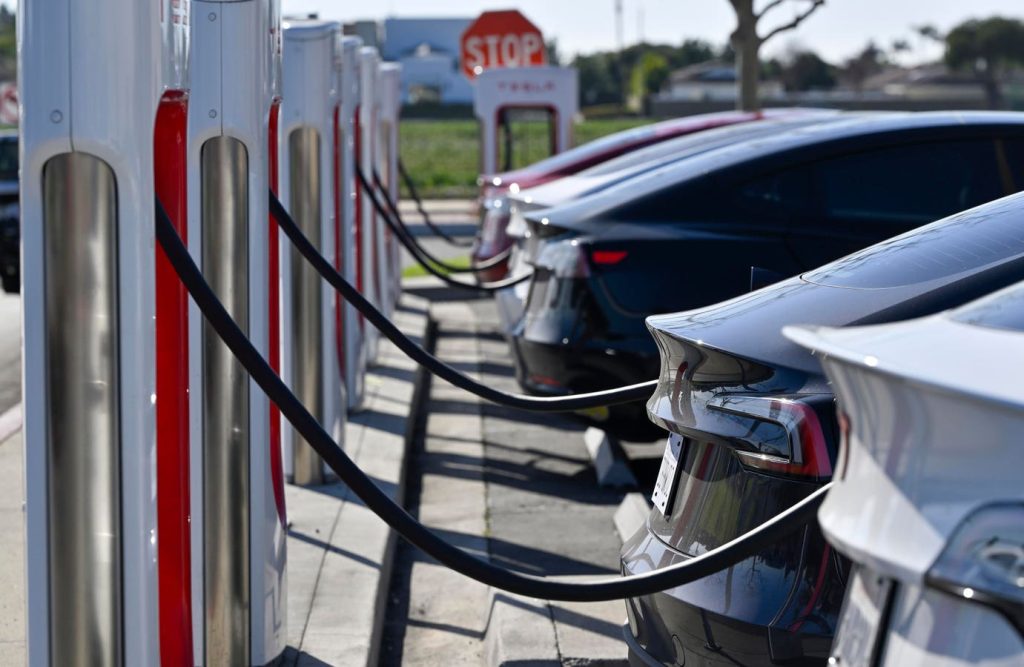Fountain Valley, CA – March 20: Drivers charge their Teslas in Fountain Valley, CA, on Wednesday, March 20, 2024. The Biden administration on Wednesday, March 20, 2024, issued one of the most significant climate regulations in the nation’s history, a rule designed to ensure that the majority of new passenger cars and light trucks sold in the United States are all-electric or hybrids by 2032. (Photo by Jeff Gritchen/MediaNews Group/Orange County Register via Getty Images)
MediaNews Group via Getty Images
The race to electrify American transportation is on. Automakers are rolling out dozens of new electric models, public incentives are spurring adoption, and projections from the Edison Electric Institute suggest the number of electric vehicles on U.S. roads could swell tenfold by 2035. But while drivers see quiet rides and lower fuel costs, utilities see something else: millions of mobile batteries plugging in at once, each drawing as much power as an extra household.
The big question is whether the grid can handle it. According to experts, the answer depends less on politics than on economics—and on whether utilities embrace a concept known as managed charging.
“This is not a political story—it’s an economic one,” says Garrett Fitzgerald, senior director of electrification at the Smart Electric Power Alliance, in an interview with me. “Either we manage charging and lower costs for everyone, or we ignore it and end up with higher bills and more power plants.”
Today, about 80% of EV charging happens at home, according to the U.S. Department of Energy, typically overnight. The other 20% occurs at public stations—for road trips or for drivers who don’t have garages or driveways. On the surface, that might seem manageable. But if millions of drivers all plug in at 6 p.m., right as air conditioners and appliances are pushing the grid to its limit, utilities will face a massive new stress point.
That’s where managed charging comes in. Rather than allowing every vehicle to charge whenever it’s plugged in, utilities and third-party providers can stagger charging, delay it until off-peak hours, or even temporarily reduce charging speeds. Customers still wake up to a full battery—but the system avoids costly spikes.
The savings potential is substantial. According to a new white paper from the EV charging optimization company ev.energy, managed charging could deliver about $575 in annual savings per EV—translating into $30 billion in system-wide benefits by 2035 if widely deployed. Consumers get lower rates while utilities avoid the expense of erecting poles and wires.
“EVs don’t have to be a burden,” says Nick Woolley, CEO of ev.energy, which partners with utilities on charging programs. “If we get this right, they can actually make the grid more reliable and affordable.”
From EV Charging Pilots To Scale
So far, managed charging has mostly been confined to small pilot programs. California utilities have experimented with it, as have regional grid operators like PJM and ISO New England. The results are promising: with modest incentives, drivers are willing to adjust their charging behavior, and utilities can balance demand more effectively.
But Woolley told me that the era of small-scale testing is over. “The conversation has shifted. This is no longer about pilots. It’s about scaling managed charging before utilities are forced into costlier, slower solutions,” he says.
The scaling question is critical. Automakers are already preparing for a future in which EVs not only draw power but also return it to the grid. Ford’s F-150 Lightning has helped introduce “vehicle-to-home” backup power, and by 2026, more manufacturers are expected to enable “vehicle-to-grid” services — allowing EVs to act as distributed storage during peak hours. That could be a game-changer, effectively turning millions of parked cars into a nationwide virtual power plant.
Accelerating the pace of managed charging is first up. The challenge isn’t the technology or drivers—it’s how utilities plan for growth. Many utilities still rely on traditional investment models, which favor poles, wires, and power plants that can be added to the rate base. New software-driven solutions, like managed charging, don’t fit neatly into those frameworks, even when they promise lower costs and greater reliability.
“We’ve proven the technology works. The value is there. Now it’s about utilities incorporating it into their planning and programs,” says Fitzgerald, with the Smart Electric Power Alliance.
Even with these structural hurdles, momentum is building. Time-of-use rates, apps that automate charging schedules, and utility-run programs are making it easier for drivers to participate. Most customers simply want low costs and a fully charged battery by morning, which the software can guarantee.
And while public charging infrastructure will remain essential for long-distance travel and apartment dwellers, it accounts for just one-fifth of charging today. That means managed charging at home—where most EV drivers plug in—can capture the lion’s share of benefits.
“If we align incentives properly, customers don’t have to think about it. The system just works smarter,” Woolley says.
The rise of EVs is inevitable. The question is whether utilities see them as a problem to be managed or as a resource to be unlocked. Managed charging offers a rare win-win: lower costs for consumers, fewer expensive power plants for utilities, and a faster, more reliable transition to clean energy.
The technology is available. The economics are straightforward. All that is left is for utilities and regulators to regard managed charging as a vital part of America’s energy future, not just an experiment.


